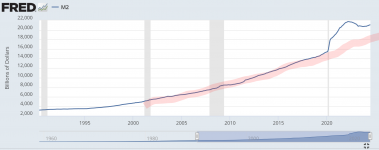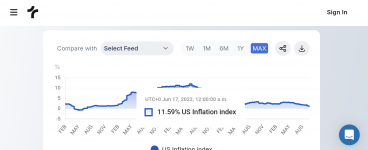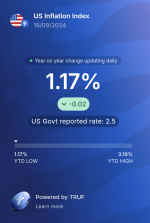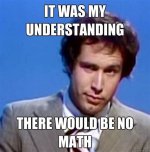Happy Rate Cut Day to all who celebrate
- Thread starter dorndawg
- Start date
You are using an out of date browser. It may not display this or other websites correctly.
You should upgrade or use an alternative browser.
You should upgrade or use an alternative browser.
Rate drops a half-point below a 2 decade high, and that’s “printing money”? Ok then.
I’ve already had 4 calls to refinance today- all dropping from the 7’s over a percent. People are anxious to get out of those higher rates.
Going to be good for us on our operating loan for next year especially if they continue to cut then.What's the cut going to be? What do you hope it is? I'll go with 25 BPS on both
ETA: 50 BPS, whoooo boy. I thought we had another hour before it dropped, time zones are hard man
I'm curious where you are getting these numbers? Not arguing, but it doesn't match what my understanding of the money printing cycle looked like.The printing was done 3 years ago. 6 trillion in circulation to 19.2 trillion.
It will take forever to correct.
Generally speaking, we are talking about M2 money supply when we talk "printing money." M2 jumped from $15.4 trillion in March of 2020 to $21.7 trillion in March of 2022. So about $6.3 trillion.

But since March of 2022, the Fed has chilled and even rolled some back. So we currently sit right at $21 trillion. Our pre COVID trajectory would have had us around $19.5 trillion right now.
That delta was/is all the inflation we experienced on everyday items in my opinion. (There's a whole other conversation about asset inflation that ran from 2009-2020 because of cheap debt that made things like home and car prices skyrocket over the decade while payments didn't.) But realistically, what we have been going through for the last 24 months or so is "dis-inflation." The lowering or slowing of the inflation rate... Not to be confused with "deflation" which is negative inflation or the actual lowering of prices. So if the inflation rate year over year dropped from 8% to 6% that is dis-inflation... Where if it went from 2% to -1% it would be deflation. A little bit of semantics, but realistically speaking, we want no part of deflation. That's 2007-8 level recession type stuff. Cause when corporate sales slow we we have hiring freezes and small layoffs... When corporate revenue declines we get mass layoffs, pay cuts, and bread lines.
The unpopular opinion/truth right now is inflation is done. I feel like it has been for close to a year. This doesn't change the fact that we are up 25% over the last 3+ years and everyday people are hurting, but dis-inflation started in the Spring of 2022.
My biggest issue with the whole thing is the garbage academia driven BLS data that has lags, smoothing, and seasonal adjustments. The slow data is what gave the Fed the idea it was transitory on the books whilst we the people were feeling 10% + inflation in late 2021 and early 2022.
I'm a huge fan of Truflation. They use real time data with no BS to calculate inflation. It peaked at 11.59% in June of 2022 and currently sits at 1.17%.


My biggest frustration is if we avoid recession (which I'm not very sure we will), people will credit Powell with his soft landing and put him up with Volker as a Fed hero. When in reality, he and the rest of the Fed 17ed this thing up royally by letting the inflation get out of hand in the first place.
In the summer of 2020, dip wads like yours truly were ringing the alarms of rapid (not hyper) inflation being immanent, while for 18 more months the people that could actually stop it started team transitory and played pandemic counselors. One look at that spike in M2 back in 2020 is all you need to see to know what was coming.
My call from here is a year or so of stagnant at best GDP growth. Flatish prices and wage growth with more layoffs than hiring and a likely light recession. 2025 is going to be slightly crappy to meh. But by 2026 Fed fund rates are back in the 2's or even high 1's and hiring will finally start to rebound as the corporate debt monsters get their cheap money supply back. Deflation is still the long term risk as technology continues to replace people in the workforce and we go back to the 2010's cycle of constantly increasing government and corporate debt to artificially manipulate growth in the economy and our everyday purchases normalize to the Fed's 2% target inflation, but big ticket items that thrive on cheap debt (houses, cars, equipment) rise in value at a more rapid rate until we are all financing our new vehicles for 120 months and buying our homes with our 40 year mortgages by 2030-2035.
I'm curious where you are getting these numbers? Not arguing, but it doesn't match what my understanding of the money printing cycle looked like.
Generally speaking, we are talking about M2 money supply when we talk "printing money." M2 jumped from $15.4 trillion in March of 2020 to $21.7 trillion in March of 2022. So about $6.3 trillion.View attachment 652849
But since March of 2022, the Fed has chilled and even rolled some back. So we currently sit right at $21 trillion. Our pre COVID trajectory would have had us around $19.5 trillion right now.
That delta was/is all the inflation we experienced on everyday items in my opinion. (There's a whole other conversation about asset inflation that ran from 2009-2020 because of cheap debt that made things like home and car prices skyrocket over the decade while payments didn't.) But realistically, what we have been going through for the last 24 months or so is "dis-inflation." The lowering or slowing of the inflation rate... Not to be confused with "deflation" which is negative inflation or the actual lowering of prices. So if the inflation rate year over year dropped from 8% to 6% that is dis-inflation... Where if it went from 2% to -1% it would be deflation. A little bit of semantics, but realistically speaking, we want no part of deflation. That's 2007-8 level recession type stuff. Cause when corporate sales slow we we have hiring freezes and small layoffs... When corporate revenue declines we get mass layoffs, pay cuts, and bread lines.
The unpopular opinion/truth right now is inflation is done. I feel like it has been for close to a year. This doesn't change the fact that we are up 25% over the last 3+ years and everyday people are hurting, but dis-inflation started in the Spring of 2022.
My biggest issue with the whole thing is the garbage academia driven BLS data that has lags, smoothing, and seasonal adjustments. The slow data is what gave the Fed the idea it was transitory on the books whilst we the people were feeling 10% + inflation in late 2021 and early 2022.
I'm a huge fan of Truflation. They use real time data with no BS to calculate inflation. It peaked at 11.59% in June of 2022 and currently sits at 1.17%.
View attachment 652850
View attachment 652851
My biggest frustration is if we avoid recession (which I'm not very sure we will), people will credit Powell with his soft landing and put him up with Volker as a Fed hero. When in reality, he and the rest of the Fed 17ed this thing up royally by letting the inflation get out of hand in the first place.
In the summer of 2020, dip wads like yours truly were ringing the alarms of rapid (not hyper) inflation being immanent, while for 18 more months the people that could actually stop it started team transitory and played pandemic counselors. One look at that spike in M2 back in 2020 is all you need to see to know what was coming.
My call from here is a year or so of stagnant at best GDP growth. Flatish prices and wage growth with more layoffs than hiring and a likely light recession. 2025 is going to be slightly crappy to meh. But by 2026 Fed fund rates are back in the 2's or even high 1's and hiring will finally start to rebound as the corporate debt monsters get their cheap money supply back. Deflation is still the long term risk as technology continues to replace people in the workforce and we go back to the 2010's cycle of constantly increasing government and corporate debt to artificially manipulate growth in the economy and our everyday purchases normalize to the Fed's 2% target inflation, but big ticket items that thrive on cheap debt (houses, cars, equipment) rise in value at a more rapid rate until we are all financing our new vehicles for 120 months and buying our homes with our 40 year mortgages by 2030-2035.

Congratulations! Longest Post EVEEER on The 6 Packs**
@PooPopsBaldHead Whats the lumber industry looking like now? I remember there for a while the price of a 2x4 had gotten something like 5x the pre covid price.
If the rates on the 10% down, second home loans drop into the low 6s...lookout NIL.
I'm curious where you are getting these numbers? Not arguing, but it doesn't match what my understanding of the money printing cycle looked like.
Generally speaking, we are talking about M2 money supply when we talk "printing money." M2 jumped from $15.4 trillion in March of 2020 to $21.7 trillion in March of 2022. So about $6.3 trillion.View attachment 652849
But since March of 2022, the Fed has chilled and even rolled some back. So we currently sit right at $21 trillion. Our pre COVID trajectory would have had us around $19.5 trillion right now.
That delta was/is all the inflation we experienced on everyday items in my opinion. (There's a whole other conversation about asset inflation that ran from 2009-2020 because of cheap debt that made things like home and car prices skyrocket over the decade while payments didn't.) But realistically, what we have been going through for the last 24 months or so is "dis-inflation." The lowering or slowing of the inflation rate... Not to be confused with "deflation" which is negative inflation or the actual lowering of prices. So if the inflation rate year over year dropped from 8% to 6% that is dis-inflation... Where if it went from 2% to -1% it would be deflation. A little bit of semantics, but realistically speaking, we want no part of deflation. That's 2007-8 level recession type stuff. Cause when corporate sales slow we we have hiring freezes and small layoffs... When corporate revenue declines we get mass layoffs, pay cuts, and bread lines.
The unpopular opinion/truth right now is inflation is done. I feel like it has been for close to a year. This doesn't change the fact that we are up 25% over the last 3+ years and everyday people are hurting, but dis-inflation started in the Spring of 2022.
My biggest issue with the whole thing is the garbage academia driven BLS data that has lags, smoothing, and seasonal adjustments. The slow data is what gave the Fed the idea it was transitory on the books whilst we the people were feeling 10% + inflation in late 2021 and early 2022.
I'm a huge fan of Truflation. They use real time data with no BS to calculate inflation. It peaked at 11.59% in June of 2022 and currently sits at 1.17%.
View attachment 652850
View attachment 652851
My biggest frustration is if we avoid recession (which I'm not very sure we will), people will credit Powell with his soft landing and put him up with Volker as a Fed hero. When in reality, he and the rest of the Fed 17ed this thing up royally by letting the inflation get out of hand in the first place.
In the summer of 2020, dip wads like yours truly were ringing the alarms of rapid (not hyper) inflation being immanent, while for 18 more months the people that could actually stop it started team transitory and played pandemic counselors. One look at that spike in M2 back in 2020 is all you need to see to know what was coming.
My call from here is a year or so of stagnant at best GDP growth. Flatish prices and wage growth with more layoffs than hiring and a likely light recession. 2025 is going to be slightly crappy to meh. But by 2026 Fed fund rates are back in the 2's or even high 1's and hiring will finally start to rebound as the corporate debt monsters get their cheap money supply back. Deflation is still the long term risk as technology continues to replace people in the workforce and we go back to the 2010's cycle of constantly increasing government and corporate debt to artificially manipulate growth in the economy and our everyday purchases normalize to the Fed's 2% target inflation, but big ticket items that thrive on cheap debt (houses, cars, equipment) rise in value at a more rapid rate until we are all financing our new vehicles for 120 months and buying our homes with our 40 year mortgages by 2030-2035.

Affectionately known as the “Glfr Trophy”
Congratulations! Longest Post EVEEER on The 6 Packs**
Rates had the drop built in already, they were never going down significantly. Probably don't get where folks "want them" til end of year. Feels like they'll hover around that 6% mark.Mortgage rates actually moved higher yesterday, so that was a bit of a bummer.
I'm curious where you are getting these numbers? Not arguing, but it doesn't match what my understanding of the money printing cycle looked like.
Generally speaking, we are talking about M2 money supply when we talk "printing money." M2 jumped from $15.4 trillion in March of 2020 to $21.7 trillion in March of 2022. So about $6.3 trillion.View attachment 652849
But since March of 2022, the Fed has chilled and even rolled some back. So we currently sit right at $21 trillion. Our pre COVID trajectory would have had us around $19.5 trillion right now.
That delta was/is all the inflation we experienced on everyday items in my opinion. (There's a whole other conversation about asset inflation that ran from 2009-2020 because of cheap debt that made things like home and car prices skyrocket over the decade while payments didn't.) But realistically, what we have been going through for the last 24 months or so is "dis-inflation." The lowering or slowing of the inflation rate... Not to be confused with "deflation" which is negative inflation or the actual lowering of prices. So if the inflation rate year over year dropped from 8% to 6% that is dis-inflation... Where if it went from 2% to -1% it would be deflation. A little bit of semantics, but realistically speaking, we want no part of deflation. That's 2007-8 level recession type stuff. Cause when corporate sales slow we we have hiring freezes and small layoffs... When corporate revenue declines we get mass layoffs, pay cuts, and bread lines.
The unpopular opinion/truth right now is inflation is done. I feel like it has been for close to a year. This doesn't change the fact that we are up 25% over the last 3+ years and everyday people are hurting, but dis-inflation started in the Spring of 2022.
My biggest issue with the whole thing is the garbage academia driven BLS data that has lags, smoothing, and seasonal adjustments. The slow data is what gave the Fed the idea it was transitory on the books whilst we the people were feeling 10% + inflation in late 2021 and early 2022.
I'm a huge fan of Truflation. They use real time data with no BS to calculate inflation. It peaked at 11.59% in June of 2022 and currently sits at 1.17%.
View attachment 652850
View attachment 652851
My biggest frustration is if we avoid recession (which I'm not very sure we will), people will credit Powell with his soft landing and put him up with Volker as a Fed hero. When in reality, he and the rest of the Fed 17ed this thing up royally by letting the inflation get out of hand in the first place.
In the summer of 2020, dip wads like yours truly were ringing the alarms of rapid (not hyper) inflation being immanent, while for 18 more months the people that could actually stop it started team transitory and played pandemic counselors. One look at that spike in M2 back in 2020 is all you need to see to know what was coming.
My call from here is a year or so of stagnant at best GDP growth. Flatish prices and wage growth with more layoffs than hiring and a likely light recession. 2025 is going to be slightly crappy to meh. But by 2026 Fed fund rates are back in the 2's or even high 1's and hiring will finally start to rebound as the corporate debt monsters get their cheap money supply back. Deflation is still the long term risk as technology continues to replace people in the workforce and we go back to the 2010's cycle of constantly increasing government and corporate debt to artificially manipulate growth in the economy and our everyday purchases normalize to the Fed's 2% target inflation, but big ticket items that thrive on cheap debt (houses, cars, equipment) rise in value at a more rapid rate until we are all financing our new vehicles for 120 months and buying our homes with our 40 year mortgages by 2030-2035.
